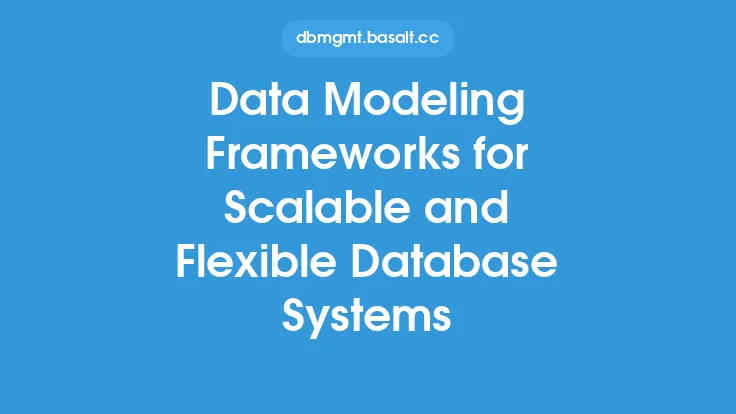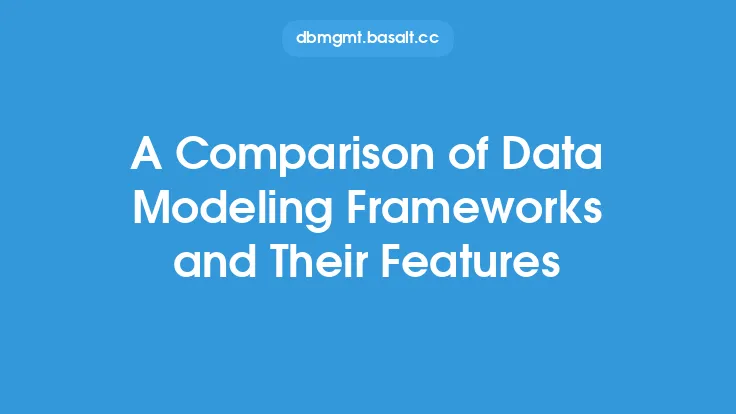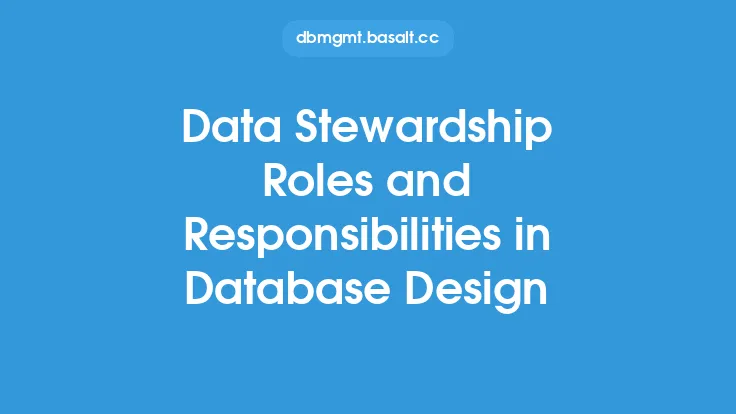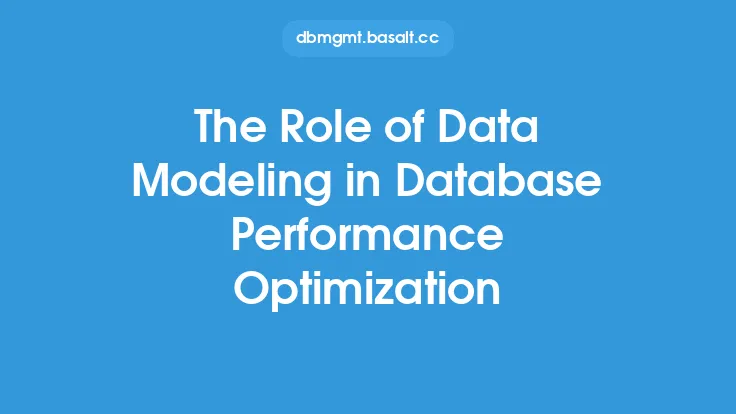Data modeling frameworks play a crucial role in the design and development of databases, as they provide a structured approach to creating a conceptual representation of the data. A data modeling framework is a set of rules, guidelines, and best practices that help data modelers to create a robust, scalable, and maintainable data model. The framework provides a common language and set of constructs that can be used to describe the data, making it easier to communicate and collaborate among stakeholders.
Importance of Data Modeling Frameworks
Data modeling frameworks are essential in database design because they help to ensure that the data model is consistent, complete, and accurate. A well-designed data model is critical to the success of any database, as it provides the foundation for the database's structure and organization. A data modeling framework helps to ensure that the data model is aligned with the business requirements and goals of the organization, and that it is able to support the needs of the users. By using a data modeling framework, data modelers can create a data model that is robust, scalable, and maintainable, and that can adapt to changing business needs.
Key Components of a Data Modeling Framework
A data modeling framework typically consists of several key components, including a set of concepts, rules, and guidelines for creating a data model. The framework may include a set of constructs, such as entities, attributes, and relationships, that can be used to describe the data. The framework may also include a set of rules and guidelines for naming and defining these constructs, as well as for creating relationships between them. Additionally, the framework may include a set of best practices and guidelines for creating a data model that is consistent, complete, and accurate.
Entity-Relationship Modeling
One of the most common data modeling frameworks is entity-relationship modeling (ERM). ERM is a framework that uses a set of constructs, including entities, attributes, and relationships, to describe the data. In ERM, an entity is a thing or concept that has independent existence, such as a customer or an order. An attribute is a characteristic or property of an entity, such as a customer's name or address. A relationship is a connection between two or more entities, such as the relationship between a customer and an order. ERM provides a set of rules and guidelines for creating entities, attributes, and relationships, and for creating a data model that is consistent, complete, and accurate.
Object-Role Modeling
Another data modeling framework is object-role modeling (ORM). ORM is a framework that uses a set of constructs, including objects, roles, and facts, to describe the data. In ORM, an object is a thing or concept that has independent existence, such as a customer or an order. A role is a part or aspect of an object, such as a customer's role as a buyer or seller. A fact is a statement or assertion about an object or role, such as the fact that a customer has a certain address. ORM provides a set of rules and guidelines for creating objects, roles, and facts, and for creating a data model that is consistent, complete, and accurate.
Dimensional Modeling
Dimensional modeling is a data modeling framework that is specifically designed for data warehousing and business intelligence applications. In dimensional modeling, the data is organized into facts and dimensions. A fact is a measure or metric, such as sales or revenue. A dimension is a category or attribute, such as time or geography. Dimensional modeling provides a set of rules and guidelines for creating facts and dimensions, and for creating a data model that is optimized for querying and analysis.
Data Modeling Frameworks and Database Design
Data modeling frameworks play a critical role in database design, as they provide a structured approach to creating a conceptual representation of the data. By using a data modeling framework, data modelers can create a data model that is robust, scalable, and maintainable, and that can adapt to changing business needs. The data model can then be used to design the database, including the creation of tables, indexes, and relationships. The data modeling framework can also be used to guide the development of the database, including the creation of views, stored procedures, and other database objects.
Best Practices for Using Data Modeling Frameworks
There are several best practices that can be used when working with data modeling frameworks. First, it is essential to choose a framework that is well-suited to the needs of the project. This may involve evaluating different frameworks and selecting the one that best meets the requirements of the project. Second, it is essential to follow the rules and guidelines of the framework, and to use the constructs and notation consistently. Third, it is essential to validate the data model against the business requirements and goals of the organization, and to make sure that it is able to support the needs of the users. Finally, it is essential to maintain and update the data model over time, as the business needs and requirements of the organization change.
Conclusion
In conclusion, data modeling frameworks play a crucial role in the design and development of databases. By providing a structured approach to creating a conceptual representation of the data, data modeling frameworks can help to ensure that the data model is consistent, complete, and accurate. There are several different data modeling frameworks available, each with its own set of constructs, rules, and guidelines. By choosing a framework that is well-suited to the needs of the project, and by following best practices for using the framework, data modelers can create a data model that is robust, scalable, and maintainable, and that can adapt to changing business needs.





